In today’s digital era, social media has had a profound effect on how we connect, share information, and approach our health and fitness. From motivational fitness posts to online workout videos and virtual coaching, social media has revolutionized the way we engage with fitness. Platforms like Instagram, Facebook, and YouTube have become essential resources for fitness inspiration, tips, and advice.
According to Statista, the global fitness and health club industry reached a market size of $87.23 billion in 2019, with steady growth expected in the years to come. This growth is, in part, fueled by the increasing presence of social media, which has become a primary source of fitness content for millions of people.
Quick Access to Fitness Information and Virtual Workouts
Social media has made fitness information more accessible than ever. Gone are the days of relying on expensive magazines or costly fitness classes. Instead, social media platforms provide a wealth of resources from fitness experts and enthusiasts worldwide, offering everything from workout tips to nutrition advice. Now, fitness content is just a click away.
Another major transformation is the rise of virtual workouts. Live workout sessions, fitness challenges, and pre-recorded workout videos allow people to exercise at home, on their own time. This convenience has been a game-changer for those with busy schedules or limited access to gyms.
The Rise of Fitness Influencers
Social media has also given rise to a new generation of fitness influencers. These individuals, often with large followings, share their fitness journeys and offer advice, inspiration, and motivation to their audiences. With their fit physiques and healthy lifestyles, fitness influencers have become role models for many people, influencing them to make fitness a part of their daily routine.
A study by Food and Health Communications found that over 40% of millennials follow at least one fitness influencer, with many doing so to achieve a healthier lifestyle. These influencers have helped shift the focus not only on physical health but also on mental well-being and self-love, making them an integral part of the fitness industry’s evolution.
Building Communities for Accountability and Support
Social media platforms have transformed into hubs for fitness communities, where people can connect with like-minded individuals. Dedicated hashtags, Facebook groups, and fitness forums allow individuals to stay accountable and motivated by sharing their goals, progress, and experiences with others.
This sense of community extends to fitness trainers and coaches as well. They can now build global online communities and offer virtual coaching, helping clients worldwide while growing their businesses. The virtual nature of these platforms has expanded the reach of fitness professionals, allowing them to share their expertise with a broader audience.
Increased Accountability Through Social Media
One significant impact of social media is the increased accountability it provides. The constant sharing of fitness journeys on platforms like Instagram and Facebook has made many people more mindful of their health. Seeing others’ progress can create a “fear of missing out” (FOMO), pushing individuals to stay focused on their fitness goals.
Additionally, social media has allowed individuals to track and share their progress, often through before-and-after photos, workout check-ins, and fitness challenges. This digital accountability has kept people engaged and motivated to continue their fitness journeys.
Frequently Asked Questions
1. How has social media impacted the fitness industry?
Social media has made fitness more accessible, provided virtual workout options, and helped build global fitness communities. It has also created opportunities for fitness influencers and professionals to connect with a larger audience and inspire healthier lifestyles.
2. What are the benefits of following fitness influencers on social media?
Fitness influencers provide motivation, inspiration, and valuable fitness tips. They also help create a sense of community and accountability, which encourages people to stay on track with their fitness goals.
3. How has social media changed the way people work out?
Social media has popularized virtual workouts, live sessions, and fitness challenges, making it easier and more convenient for individuals to work out at home or anywhere. It has also created a wealth of fitness content that anyone can access at any time.
4. How has social media influenced people’s attitudes toward fitness?
Social media has encouraged more people to prioritize their physical and mental health. Exposure to fitness content has sparked a desire to integrate exercise into daily life, driven by the fear of missing out (FOMO) on the benefits of staying active.
5. Are there any negative effects of social media on the fitness industry?
While social media has contributed many positive changes, it has also led to negative aspects, such as body comparison and the promotion of unrealistic beauty standards. However, efforts are being made to promote body positivity and inclusivity within the fitness community.
Conclusion
Social media has undeniably reshaped the fitness industry, making it more accessible and inclusive than ever before. It has connected individuals globally, provided endless fitness resources, and fostered a sense of community. As social media continues to evolve, it will be exciting to see how it further influences the way people approach fitness and health, helping more individuals lead healthier lives.

Leave a Comment